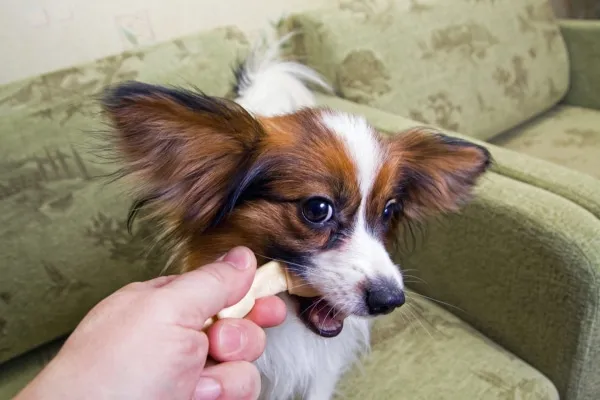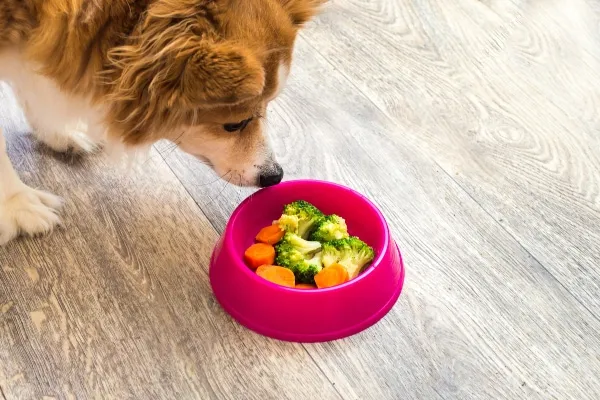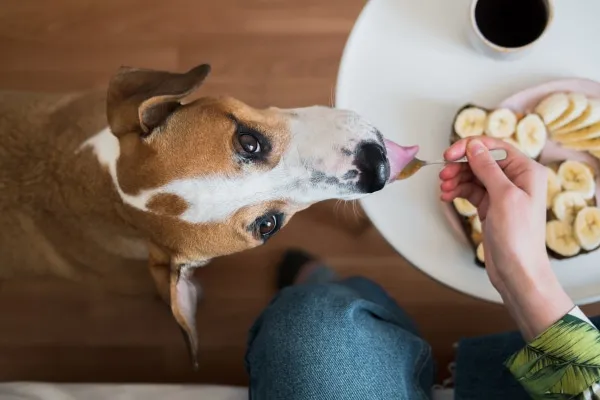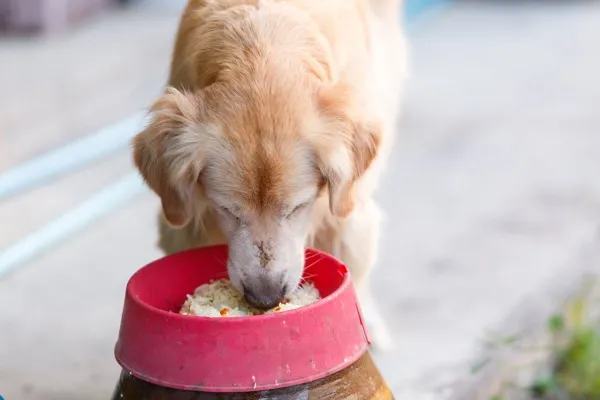Navigating the world of diet for a diabetic dog can feel like a daunting task. As a loving pet parent, you want to ensure your furry friend is healthy and happy, but understanding which human foods and treats are safe can be confusing. From chicken breast to eggs, coconut oil to certain fruits and vegetables, the questions can pile up. At Dog Care Story, we understand your concerns, and our aim is to provide you with a comprehensive, veterinarian-backed guide to making the best dietary choices for your diabetic companion.
Just recently, our expert team consulted with a Goldendoodle named Tina, an 8-year-old diagnosed with diabetes. Her owner, like many of you, had numerous questions about managing her dog’s condition, including concerns about diabetic ketoacidosis and what to do if a diabetic dog won’t eat. A major part of the discussion revolved around what human foods are permissible for a diabetic dog. This article will address that very question, focusing on safe and unsafe human food options, as well as suitable treats and supplements, to help you better manage your dog’s health.
Why Diet is Crucial for Diabetic Dogs
Before diving into specific food items, let’s understand why your dog’s diet plays such a pivotal role in managing diabetes. As your veterinarian has likely explained, your dog’s body breaks down the food it consumes into various components, including glucose, or sugar. Different foods release sugar into the bloodstream at different rates – some rapidly, others slowly.
In a healthy dog, the pancreas responds to food intake by secreting insulin, a hormone vital for lowering blood sugar. Insulin facilitates the movement of glucose into cells, where it’s used as energy, keeping blood sugar levels within a healthy, narrow range.
Diabetic Dogs Need Insulin and Consistent Meal Times
For a diabetic dog, the pancreas doesn’t produce enough insulin, necessitating insulin injections as a “substitute pancreas.” While effective, this external insulin administration isn’t as precise as the body’s natural regulation. Therefore, the type and timing of food become critical factors in maintaining stable blood sugar levels.
Vets typically recommend feeding your diabetic dog two distinct meals a day, approximately 12 hours apart, followed by an insulin injection once the meal is finished. Since long-acting insulin works for about 12 hours, this twice-daily feeding and insulin schedule helps prevent dangerous blood sugar spikes or drops. Consistency in food composition, quantity, and feeding times is key to this management strategy. If you find your dog is a picky eater or you’re wondering what to give a dog to make her eat, addressing these issues proactively is essential for stable blood sugar control.
Specific Nutritional Needs for Diabetic Canines
The specific nutritional profile of your dog’s food greatly assists in blood sugar regulation. Generally, a diabetic dog’s diet should be high in fiber, low in fat, low in calories, and contain a moderate to high amount of protein. Some dogs thrive on prescription diabetic dog food, specifically formulated for their needs, while others may do well on certain over-the-counter diets that meet these parameters. It’s often a process of finding what works best for your individual dog under veterinary guidance.
Making dietary adjustments can be challenging, especially if your dog is accustomed to table scraps. The good news is that there are still many human foods you can safely offer your diabetic dog, making meal times enjoyable and varied.
Let’s delve into some frequently asked questions about what human food a diabetic dog can eat.
 A small poodle, a diabetic dog, sits attentively at a table with a bowl of plain cooked chicken and steamed vegetables, representing safe human food options for dogs with diabetes.
A small poodle, a diabetic dog, sits attentively at a table with a bowl of plain cooked chicken and steamed vegetables, representing safe human food options for dogs with diabetes.
Safe Human Meats for Diabetic Dogs
Meats are often high on the list of human foods owners want to share with their dogs. Let’s explore which ones are safe for your diabetic companion.
Can a Diabetic Dog Eat Chicken Breast?
One of the most common inquiries we receive is about chicken breast. The answer is generally yes, chicken is safe for diabetic dogs to eat. Chicken is an excellent source of lean protein and essential nutrients. It also has a significantly lower fat content compared to other meats like beef or pork, which is beneficial for managing your diabetic dog’s weight and blood sugar.
However, it’s crucial how you prepare it. If you’re going to feed your diabetic dog chicken breast, ensure it’s cooked plainly – without butter, oils, or seasonings. The skin should always be removed as it’s high in fat. These “extras” can negatively impact your dog’s blood sugar and overall health. Furthermore, many common seasonings, such as garlic and onions, are toxic to dogs and must be avoided.
Meats to Avoid for Diabetic Dogs
While chicken is a great option, certain meats should be strictly avoided due to their high-fat content. These include:
- Ground beef
- Beef burgers
- Pork chops
- Bacon
These meats are problematic because their high-fat and high-calorie content can hinder effective blood glucose control. Diabetic dogs need to maintain a healthy body condition score (BCS) to help manage their diabetes, and excess calories from fatty foods can lead to weight gain. High-fat meals can also slow down digestion, making it harder for insulin to work efficiently.
Most importantly, fatty foods significantly increase the risk of pancreatitis in dogs. This severe inflammation of the pancreas can be life-threatening, causing vomiting, diarrhea, and intense abdominal pain. Diabetic dogs are already predisposed to pancreatitis, so adding high-fat foods to their diet is a dangerous choice. If your dog has pancreatitis, understanding what he can eat is vital for recovery and ongoing management.
Other Safe Meat Options
If your dog doesn’t eat chicken or you’re looking for variety, several other safe meat options exist:
- Turkey: Similar to chicken, lean, plain-cooked turkey (without skin or seasonings) is a high-protein, low-fat alternative. Be aware that some dogs allergic to chicken might also react to turkey.
- Fish (e.g., Salmon): Fish like salmon can be a safe and healthy meat source. Salmon is lower in cholesterol and fat than red meat, making it a good choice. Ensure it’s cooked plainly and deboned.
- Beef Liver: Surprisingly, while most beef products are high in fat, beef liver is very low in fat and calories. This makes it a low glycemic index food, meaning it causes a slow, steady rise in blood sugar rather than a rapid spike. Additionally, beef liver is packed with essential vitamins and minerals, offering great nutritional benefits.
Choosing Treats for Diabetic Dogs
Finding suitable treats for diabetic dogs can be tricky, as many commercial dog treats are high in sugar and are considered high-glycemic foods. However, options exist to keep treat time fun and safe.
Some dog food companies that produce diabetic-specific dog food also offer diabetic-friendly treats. These typically come in biscuit or cookie form, mirroring the formulation of prescription diabetic diets – low in calories, without added sugars, and easily metabolized. They offer convenience for busy pet owners.
Always consult your veterinarian for recommendations on commercial diabetic treats. Even with vet approval, portion control is essential. Treats should make up less than 10% of your diabetic dog’s daily caloric intake to prevent disrupting blood sugar regulation.
Can Diabetic Dogs Eat Rawhides?
 A Papillon dog gnawing on a rawhide, which is not recommended for diabetic dogs or non-diabetic dogs due to potential health risks.
A Papillon dog gnawing on a rawhide, which is not recommended for diabetic dogs or non-diabetic dogs due to potential health risks.
Rawhides are generally not recommended for any dog, diabetic or not, due to several health concerns:
- Dental Health: Rawhides can cause tooth fractures, leading to pain, abscesses, or the need for tooth extractions.
- Gastrointestinal Issues: They are not easily digestible and can cause blockages in the esophagus, stomach, or intestines if large pieces are swallowed.
- Upset Stomach/Pancreatitis: Flavored rawhides may contain ingredients that can upset your dog’s stomach or even trigger pancreatitis.
- Calorie Density: Rawhides are often surprisingly calorie-dense. A small rawhide chew can contain 50 to 100 calories, which is significant for a diabetic dog who needs careful calorie management. For diabetic dogs, low-calorie options are paramount, making rawhides a definite no.
What are Some Good Chews and Toys for Diabetic Dogs?
Once rawhides are off the table, the next question is often about safe alternatives. Since managing diabetes involves calorie control, we highly recommend non-food-based chews and toys. You can find many excellent options in our article on safe chew toys for dogs.
However, if your dog prefers edible chews, a favorite solution is to fill a Kong toy with a small portion of their regular diabetic-safe kibble. This encourages mental stimulation and chewing while using a food item you know is safe and accounted for in their daily caloric intake.
If non-food chews or Kongs aren’t appealing, small amounts of certain diabetic-safe vegetables can serve as healthy chew treats.
Which Vegetables Are Safe for Diabetic Dogs?
Vegetables can be fantastic additions to your dog’s diet, both as treats and meal enhancements. However, not all vegetables are ideal for diabetic dogs. Let’s look at some common options.
Carrots
Yes, diabetic dogs can eat carrots! They are very low in calories and packed with beneficial vitamins and minerals. Carrots’ slightly sweet taste often makes them more palatable to dogs. When fed raw, their crunchiness also makes them a great, natural chew.
However, carrots do have a higher natural sugar content than many other vegetables, so they should be given in moderation to diabetic dogs.
 Carrots and broccoli, seen as excellent treats for a diabetic dog, are displayed on a white surface, highlighting safe human food options.
Carrots and broccoli, seen as excellent treats for a diabetic dog, are displayed on a white surface, highlighting safe human food options.
Broccoli
This green, floreted vegetable is an excellent snack for diabetic dogs. Broccoli has a very low glycemic index, meaning it won’t cause a rapid spike in blood sugar. It’s also extremely high in fiber, which is particularly beneficial for dogs with diabetes, aiding in digestion and blood sugar stability.
Beyond being a treat, broccoli can be incorporated into meals, especially for dogs on a weight management plan. It’s very filling, helping your dog feel satisfied even with smaller portion sizes. Always serve broccoli in bite-sized pieces to prevent choking hazards.
Sweet Potatoes and Potatoes
While sweet potatoes are popular for many dogs, we do not recommend them for diabetic dogs. Despite being high in fiber, they have a very high sugar content and a high glycemic index, which can cause rapid increases in blood glucose.
Similarly, regular potatoes should be avoided for diabetic dogs as they can also lead to significant blood sugar spikes.
Celery
Diabetic dogs can eat celery. It’s low in calories, fat, and cholesterol, making it a healthy treat option. However, celery isn’t as flavorful as some other vegetables, so your dog might not be as enthusiastic about it.
Cucumbers
Technically, cucumbers are safe for diabetic dogs due to their low-calorie and low-starch content, meaning they won’t significantly impact blood sugar. However, we generally recommend caution or avoidance with cucumbers because their shape and texture can pose a choking hazard. If given, they must be cut into very small pieces, and only offered in tiny amounts to prevent stomach upset or potential blockages.
Navigating Fruits for Diabetic Dogs
When it comes to fruits, more caution is needed for diabetic dogs. Many fruits are naturally high in sugar and starch, which can complicate blood glucose regulation. However, some fruits offer good fiber levels that can be beneficial.
Apples
Apples are a prime example of a fruit with excellent nutritional benefits but require careful consideration for diabetic dogs. They are a good source of vitamins A and C, benefiting the immune system, and are high in fiber. However, their natural sugar content is also quite high, which isn’t ideal for diabetics. For this reason, we recommend offering only occasional, tiny bites of apple to a diabetic dog.
Bananas
Despite being a tasty treat for many dogs, we generally advise against feeding bananas to diabetic dogs. While rich in vitamins and minerals, bananas have a high sugar content and glycemic index. Even for non-diabetic dogs, bananas should be given sparingly as an occasional small treat. For our diabetic companions, it’s safer to avoid them entirely.
 A dog joyfully licking a spoon coated with a mixture of peanut butter and banana, illustrating typical treats that require caution for diabetic dogs.
A dog joyfully licking a spoon coated with a mixture of peanut butter and banana, illustrating typical treats that require caution for diabetic dogs.
Watermelon and Strawberries
Unfortunately, delicious fruits like watermelon and strawberries are too high in sugar for diabetic dogs and should be avoided. For more detailed information, consult our guide on what fruits are not allowed for dogs.
Blueberries
Unlike the fruits mentioned above, blueberries can be eaten by diabetic dogs. They are an excellent source of vitamin C and fiber. The high fiber content aids digestion and contributes to better blood sugar management. Additionally, blueberries are lower in sugar compared to many other fruits.
Nevertheless, blueberries still contain more sugar than vegetables or your dog’s prescription diabetic food. Therefore, they should be given in moderation as an occasional treat.
Pumpkin
If we had to pick an ideal fruit for a diabetic dog, pumpkin would be at the top of the list. Canned pumpkin for dogs offers numerous nutritional benefits, including a good source of vitamin A. Crucially for diabetic pets, pumpkin has a very high fiber content, making it a safe and helpful food. It’s also low in calories, which can assist with weight management.
A critical point to remember when feeding pumpkin: always use pure, canned pumpkin, not pumpkin pie filling. Pumpkin pie filling contains added spices and sweeteners, some of which, like xylitol (birch sugar), are extremely toxic to dogs. Xylitol is highly dangerous for dogs and can cause rapid, life-threatening drops in blood sugar.
Other Human Foods for Diabetic Dogs
Beyond meats, fruits, and vegetables, there are other common human foods that owners often consider.
Eggs
Diabetic dogs can eat eggs! They are an excellent source of protein and contain other vital nutrients important for your dog’s health. Unlike many other foods discussed, eggs are not high in sugar, making them less likely to impact your dog’s glucose levels.
Always fully cook eggs to eliminate the risk of salmonella. Scrambled or boiled eggs are fine, but avoid adding seasonings or butter, which can be harmful.
White and Brown Rice
While white rice is often recommended as part of a bland diet for dogs suffering from an upset stomach, it generally should be avoided for diabetic dogs. It provides little nutritional value and is primarily empty calories with a higher glycemic index than recommended for diabetic management.
 A small bowl of cooked white rice, which is often recommended for sick dogs but should generally be avoided for diabetic dogs due to its potential impact on blood sugar.
A small bowl of cooked white rice, which is often recommended for sick dogs but should generally be avoided for diabetic dogs due to its potential impact on blood sugar.
Brown rice is slightly more nutritious than white rice but can still cause blood sugar levels to rise in diabetic dogs. Therefore, we generally advise clients to avoid rice for diabetic pets. You should always aim for balanced foods that dogs can eat under normal circumstances, but for diabetic dogs, even more caution is needed.
Cheese
Dogs often love cheese, but its higher fat and cholesterol content make it less ideal for diabetic dogs. However, very small portions of low-fat cheeses can sometimes be given. Cheese can be a good source of protein, vitamins, and minerals, and can be useful for hiding pills if your dog won’t take medication. If you choose to offer low-fat cheese, do so very sparingly and in moderation.
Peanut Butter
When asked if diabetic dogs can eat peanut butter, the answer isn’t straightforward due to the wide variety of brands and formulations. Many peanut butters have high sugar content and should be avoided. However, high-quality, natural peanut butter with no added sugar or other additives can be somewhat safer.
These types of peanut butter can provide an excellent source of protein and nutrients. Yet, moderation is crucial because the fat content can still affect your dog’s sugar levels or trigger pancreatitis.
Always discuss specific peanut butter brands with your veterinarian to determine if they are safe for your diabetic dog and in what quantity. Most importantly, always check the label for xylitol (also known as birch sugar), an artificial sweetener that is extremely toxic to dogs and found in some peanut butter brands.
Supplements for Diabetic Dogs
Finally, let’s briefly discuss supplements, focusing on two common ones: coconut oil and joint supplements.
Can Diabetic Dogs Have Coconut Oil?
Coconut oil is a popular supplement among dog owners, often used to improve skin and coat health, support the immune system, and help with arthritis. However, for diabetic dogs, we generally do not recommend coconut oil. While it may be lower in sugar than some other products, it is very rich in saturated fat. This high-fat content can lead to undesirable weight gain or, more seriously, pancreatitis, both of which are critical to avoid in diabetic dogs.
We advise discussing safe alternatives with your veterinarian if you’re looking for supplements to support your diabetic dog’s skin, coat, or immune system.
Can Diabetic Dogs Take Joint Supplements?
 A senior dog comfortably positioned, eating a supplement from a hand, illustrating that some supplements, like Dr. Buzby's Encore Mobility, can be safe for dogs with diabetes to support joint health.
A senior dog comfortably positioned, eating a supplement from a hand, illustrating that some supplements, like Dr. Buzby's Encore Mobility, can be safe for dogs with diabetes to support joint health.
Dogs are often diagnosed with diabetes between 7 and 10 years of age, meaning there’s a good chance they also have some degree of osteoarthritis. This frequently leads to questions about the safety of joint supplements for dogs with diabetes. Fortunately, many joint supplements are safe for diabetic dogs. However, it’s always best to get your veterinarian’s approval for any new supplement, as they have your dog’s full medical history.
For arthritic dogs or those with joint disease, many veterinarians recommend specialized joint supplements formulated to be safe for diabetic pets. These often contain ingredients like New Zealand deer antler velvet and green-lipped mussel, known for their joint-supporting properties without negatively impacting blood sugar.
Always Consult Your Veterinarian!
While this guide covers a wide array of meats, fruits, vegetables, and other human foods, as well as supplements and treats, it’s impossible to address every single food item you might consider offering your diabetic dog. Navigating life with a newly diagnosed diabetic dog can be challenging, but you don’t have to do it alone.
Your veterinarian is an invaluable resource for sorting out what you should and should not feed your diabetic dog. If you ever have specific questions about a particular food or treat, always consult them. When doing so, it’s helpful to bring the actual product (e.g., supplement bottle, peanut butter jar) or a clear picture of its label, including nutrition and ingredient information. This allows your vet to make an informed decision based on the specific components of the product.
Food is a significant part of many dogs’ lives and often strengthens the bond you share. A diabetes diagnosis doesn’t mean this bond has to change. By using the information in this article, consulting your vet with questions, and consistently managing their diet, you can continue to enjoy a fulfilling life with your diabetic dog while keeping their blood sugar under control.
